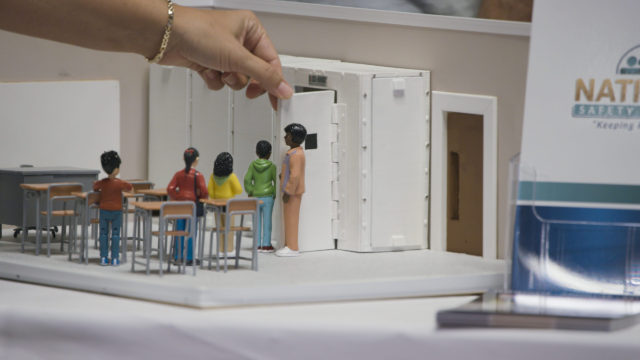
Bulletproof reveals the capitalization and marketing of school shootings (photo © Emily Topper)
BULLETPROOF (Todd Chandler, 2020)
Metrograph
7 Ludlow St. between Canal & Hester Sts.
Opens Friday, October 29
212-660-0312
nyc.metrograph.com
There’s a powerful moment near the end of Todd Chandler’s Bulletproof that I won’t soon forget. It takes place at a shooting range, where an employee is sweeping up hundreds of spent shells from guns fired by teachers and parents learning how to defend themselves in the event of a school shooting. The casings evoke the many horrific deaths of children around the country who’ve been killed just because they went to class that day, their stories swept away as the next massacre awaits.
Bulletproof sounds like a thriller, and in many ways it is. When I was a kid, we were taught to duck and cover, hiding under our desks or in the halls to survive a nuclear threat that, fortunately, never came to fruition. But today’s children face a far greater danger from school shootings, although one person in the film does note that they are more likely to die in an airplane crash than by a bullet in school. Chandler (Flood Tide, A Debtors’ Prison) and cinematographer Emily Topper (After Tiller, The Departure) travel to schools in Missouri, Texas, Chicago, Pittsburgh, California, Colorado, and New York, filming shooter drills, local hearings, and presentations from safety officers that use scare tactics and fear to convince districts they need to hire armed security guards and give the teachers guns. “The threat always comes from inside,” a Texas principal says. Another man explains, “Some people will say, ‘That’s just some kid playing,’ but the problem is, we can’t take that risk anymore.” Chandler intercuts scenes of kids just being kids, learning math, going to homecoming, and kicking a ball around.
The Texas principal boasts of having spent forty thousand dollars on twenty-two AR-15s for nineteen security officers. A Pittsburgh policeman is met with resistance when he blames school shootings on prescription SSRIs. Teachers play a life-size video game placing them in the middle of a mass shooting in a gym. A man shows off an all-pervasive surveillance system. A young Bay Area tech worker postpones getting her Master’s and instead starts making bulletproof Kevlar Wonder Hoodies. A school safety convention in Las Vegas reveals capitalism at its best as companies push bulletproof whiteboards and desks, safety lockers displayed in a colorful toylike diorama, and an electronic flashbang that can be used as a distraction device. They are all marketing to panic and monetizing trauma, but you can still take a selfie with a pair of scantily clad women in blue sequins.
Chandler doesn’t speak with any talking-head experts or pundits; instead, Bulletproof is more of a fly-on-the-wall Maysles-like documentary in which the audience gets more than a peek at how the plague of school shootings is being dealt with in these local communities. There are no statistics, no news reports, no debates over guns and the NRA; none of the participants in the film are identified, primarily because they are us, and we are them. America is in crisis, and, as Chandler shows, much of America has gone into crisis mode, to the extreme, when it comes to addressing school shootings, of which, according to CNN, there have been 180 since 2009, with 365 victims.
Are any of these security measures going to work? Chandler might not answer that question directly, but the image of a broom sweeping shell casings like so many dead bodies makes a strong point.
Bulletproof opens October 29 at Metrograph, with Chandler on hand for Q&As at the 8:30 screening on Friday night and the 7:00 show on November 1, when he will be joined by fellow documentarian Kirsten Johnson (Cameraperson, Dick Johnson Is Dead).